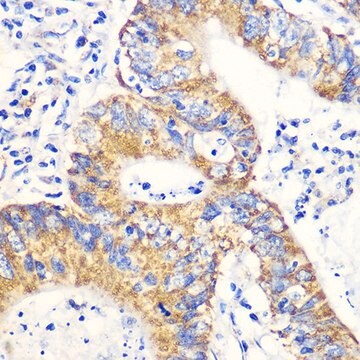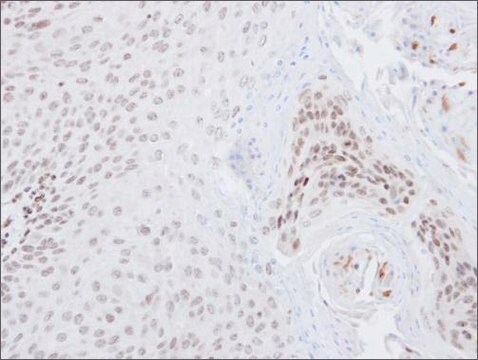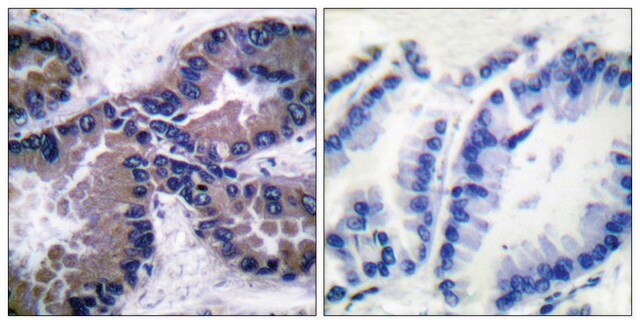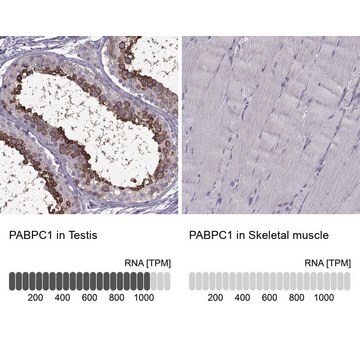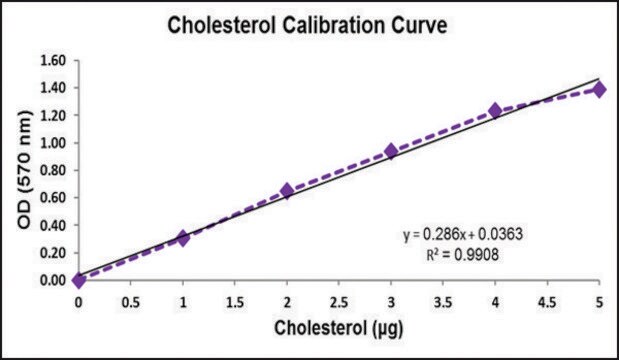推薦產品
生物源
rabbit
品質等級
共軛
unconjugated
抗體表格
affinity isolated antibody
抗體產品種類
primary antibodies
無性繁殖
polyclonal
產品線
Prestige Antibodies® Powered by Atlas Antibodies
形狀
buffered aqueous glycerol solution
物種活性
mouse, human
技術
immunoblotting: 0.04-0.4 μg/mL
immunohistochemistry: 1:50-1:200
免疫原序列
MSIEEKMEADARSIYVGNVDYGATAEELEAHFHGCGSVNRVTILCDKFSGHPKGFAYIEFSDKESVRTSLALDESLFRGRQIKVIPKRTNRPGISTTDRGFPRARYRARTTNYNSSRSRFYSGFNSRPRGRVYRGRARATSWY
UniProt登錄號
運輸包裝
wet ice
儲存溫度
−20°C
目標翻譯後修改
unmodified
基因資訊
human ... PABPN1(8106)
尋找類似的產品? 前往 產品比較指南
一般說明
PABPN1 (poly(A) binding protein, nuclear 1) is a member of the PABP protein family, which resides in the nucleus. PABPC1 is a resident of the cytoplasm. PABPN1 was initially identified in vitro, as a protein facilitating the formation of RNA poly(A) tails. This protein has a ubiquitous expression pattern. This gene is localized to human chromosome 14q11.2-q13. The encoded protein is composed of 306 amino acids, and has a molecular weight of 32.8kDa. Its N-terminal is acidic in nature, and it contains a conserved RRM domain (RNA recognition motif) in its central region, followed by the C-terminal. There are 10 consecutive alanine residues in its N-terminal.
免疫原
poly(A) binding protein, nuclear 1
應用
All Prestige Antibodies Powered by Atlas Antibodies are developed and validated by the Human Protein Atlas (HPA) project and as a result, are supported by the most extensive characterization in the industry.
The Human Protein Atlas project can be subdivided into three efforts: Human Tissue Atlas, Cancer Atlas, and Human Cell Atlas. The antibodies that have been generated in support of the Tissue and Cancer Atlas projects have been tested by immunohistochemistry against hundreds of normal and disease tissues and through the recent efforts of the Human Cell Atlas project, many have been characterized by immunofluorescence to map the human proteome not only at the tissue level but now at the subcellular level. These images and the collection of this vast data set can be viewed on the Human Protein Atlas (HPA) site by clicking on the Image Gallery link. We also provide Prestige Antibodies® protocols and other useful information.
The Human Protein Atlas project can be subdivided into three efforts: Human Tissue Atlas, Cancer Atlas, and Human Cell Atlas. The antibodies that have been generated in support of the Tissue and Cancer Atlas projects have been tested by immunohistochemistry against hundreds of normal and disease tissues and through the recent efforts of the Human Cell Atlas project, many have been characterized by immunofluorescence to map the human proteome not only at the tissue level but now at the subcellular level. These images and the collection of this vast data set can be viewed on the Human Protein Atlas (HPA) site by clicking on the Image Gallery link. We also provide Prestige Antibodies® protocols and other useful information.
生化/生理作用
PABPN1 (poly(A) binding protein, nuclear 1) is involved in pre-mRNA processing in the nucleus. It promotes the synthesis, as well as controls the length of the poly(A) tail at the 3′ end of the mRNA. It binds to the nascent mRNA transcript and controls the poly(A) tract elongation process in multicellular organisms. The protein may promote tumor aggressiveness by releasing the cancer cells from microRNA-mediated gene regulation. Mutations in this gene are associated with oculopharyngeal muscular dystrophy (OPMD) disorder. It is autosomal dominant in nature, and is a late onset muscular dystrophy disorder. It is characterized by drooping eyelids, difficulty in swallowing and weakness in proximal limbs.
特點和優勢
Prestige Antibodies® are highly characterized and extensively validated antibodies with the added benefit of all available characterization data for each target being accessible via the Human Protein Atlas portal linked just below the product name at the top of this page. The uniqueness and low cross-reactivity of the Prestige Antibodies® to other proteins are due to a thorough selection of antigen regions, affinity purification, and stringent selection. Prestige antigen controls are available for every corresponding Prestige Antibody and can be found in the linkage section.
Every Prestige Antibody is tested in the following ways:
Every Prestige Antibody is tested in the following ways:
- IHC tissue array of 44 normal human tissues and 20 of the most common cancer type tissues.
- Protein array of 364 human recombinant protein fragments.
聯結
Corresponding Antigen APREST70406
外觀
Solution in phosphate-buffered saline, pH 7.2, containing 40% glycerol and 0.02% sodium azide
法律資訊
Prestige Antibodies is a registered trademark of Merck KGaA, Darmstadt, Germany
免責聲明
Unless otherwise stated in our catalog or other company documentation accompanying the product(s), our products are intended for research use only and are not to be used for any other purpose, which includes but is not limited to, unauthorized commercial uses, in vitro diagnostic uses, ex vivo or in vivo therapeutic uses or any type of consumption or application to humans or animals.
未找到適合的產品?
試用我們的產品選擇工具.
儲存類別代碼
10 - Combustible liquids
水污染物質分類(WGK)
WGK 1
閃點(°F)
Not applicable
閃點(°C)
Not applicable
個人防護裝備
Eyeshields, Gloves, multi-purpose combination respirator cartridge (US)
Junji Ichinose et al.
Cancer science, 105(9), 1135-1141 (2014-07-01)
Alternative polyadenylation (APA), which induces shortening of the 3'UTR, is emerging as an important phenomenon in gene regulation. APA is involved in development, cancer and cell proliferation. APA may lead to disruption of microRNA-mediated gene silencing in cancer cells via
B Brais et al.
Human molecular genetics, 4(3), 429-434 (1995-03-01)
Oculopharyngeal muscular dystrophy (OPMD) is a late-onset autosomal dominant muscular dystrophy which presents typically after the age of 50 with progressive eyelid drooping and an increasing difficulty in swallowing. Though OPMD has a world-wide incidence, it is more common in
Reno Winter et al.
The Journal of biological chemistry, 287(27), 22662-22671 (2012-05-10)
Oculopharyngeal muscular dystrophy is a late-onset disease caused by an elongation of a natural 10-alanine segment within the N-terminal domain of the nuclear poly(A)-binding protein 1 (PABPN1) to maximally 17 alanines. The disease is characterized by intranuclear deposits consisting primarily
Yves B Beaulieu et al.
PLoS genetics, 8(11), e1003078-e1003078 (2012-11-21)
The poly(A)-binding protein nuclear 1 (PABPN1) is a ubiquitously expressed protein that is thought to function during mRNA poly(A) tail synthesis in the nucleus. Despite the predicted role of PABPN1 in mRNA polyadenylation, little is known about the impact of
Rumpa Biswas Bhattacharjee et al.
Cell biology international, 36(8), 697-704 (2012-04-24)
The PABPN1 [nuclear poly(A)-binding protein 1] is ubiquitous, binds to the nascent mRNA transcript and controls the poly(A) tract elongation process in multicellular organisms. Expansion of GCG repeats that encode first 6 of the 10 alanine residues of a polyalanine
我們的科學家團隊在所有研究領域都有豐富的經驗,包括生命科學、材料科學、化學合成、色譜、分析等.
聯絡技術服務